Industry Spotlight
Powering Wineries With Sustainable Energy
Comprehensive Solar Services
From initial consultation to ongoing support, we provide a full suite of services to ensure your solar investment delivers maximum value.
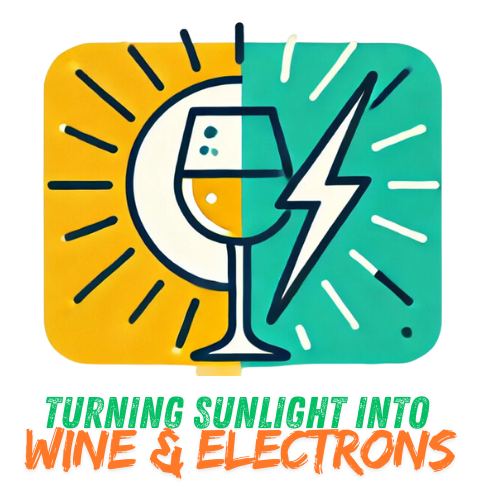
Vineyards harness sunlight for grape growth and solar-powered operations, blending traditional viticulture with modern sustainability.
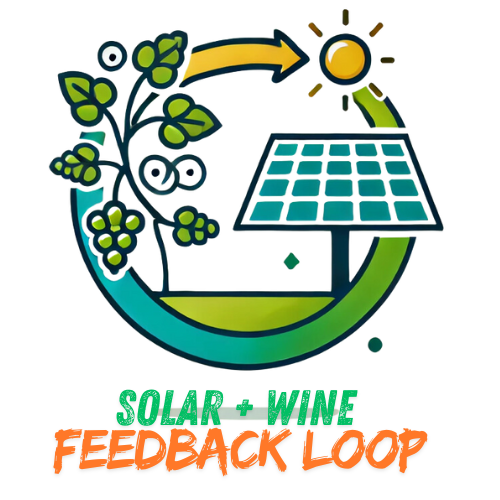
The sun powering grape growth while also generating electricity which then in turn powers wine manufacturing processes.
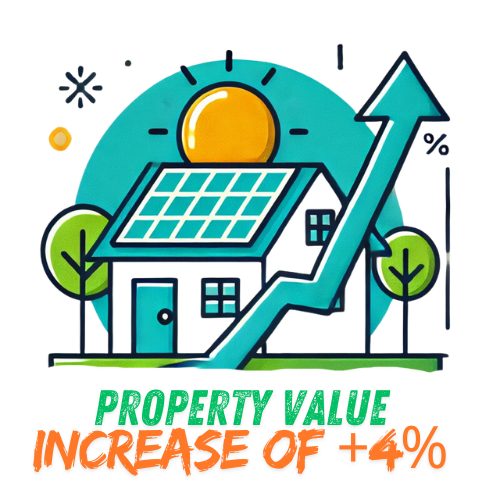
Studies show that installing solar panels can boost winery property values by over four percent, enhancing energy productivity and sustainability.

Be a Solar + Wine Trend Starter and capture a branding opportunity that brings new customers to your product.

Maximize returns with grants (RECAP, Avg $50,000) , tax rebates ($5000+), and credits (30%) for sustainable business practices.
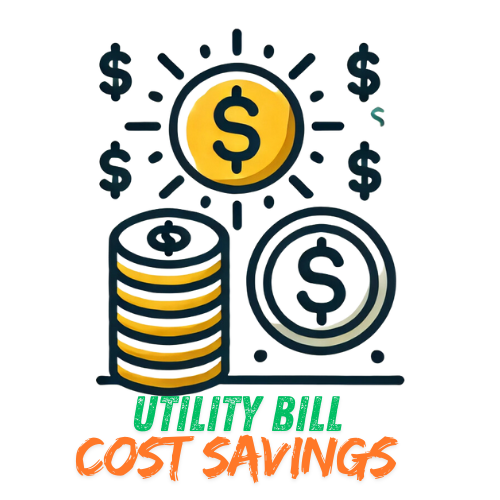
Maximize utility bill cost savings with solar energy, significantly reducing expenses by potentially offsetting all winery manufacturing and guest and office heating needs.
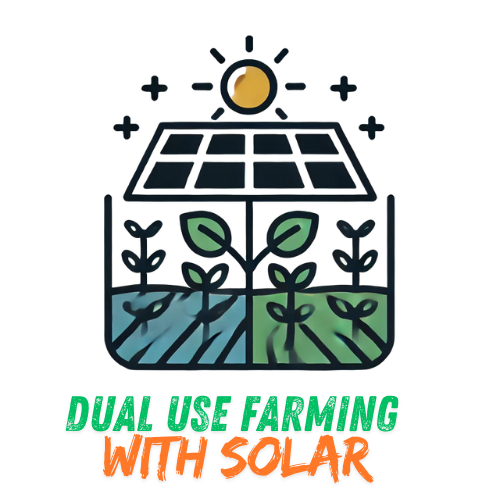
Dual-purpose agrivoltaics integrates solar panels with agriculture, lowering vineyard energy costs and enhancing plant health.
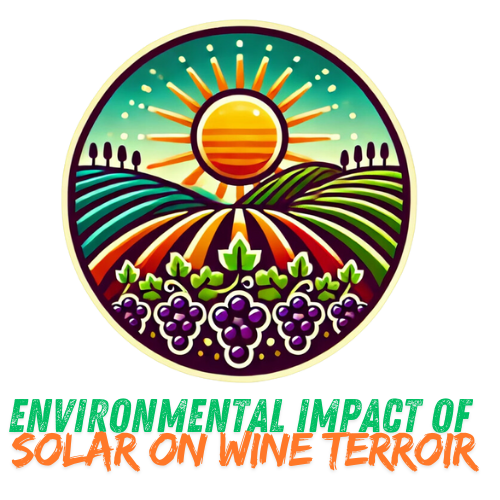
Explore the environmental impact of solar on wine terroir, harnessing the sun to improve vineyard health and wine quality.
How Many Light Bulbs Does It Take? — Discover the Solar Energy Light Bulb Equivalent of Producing One Bottle of Oregon Wine
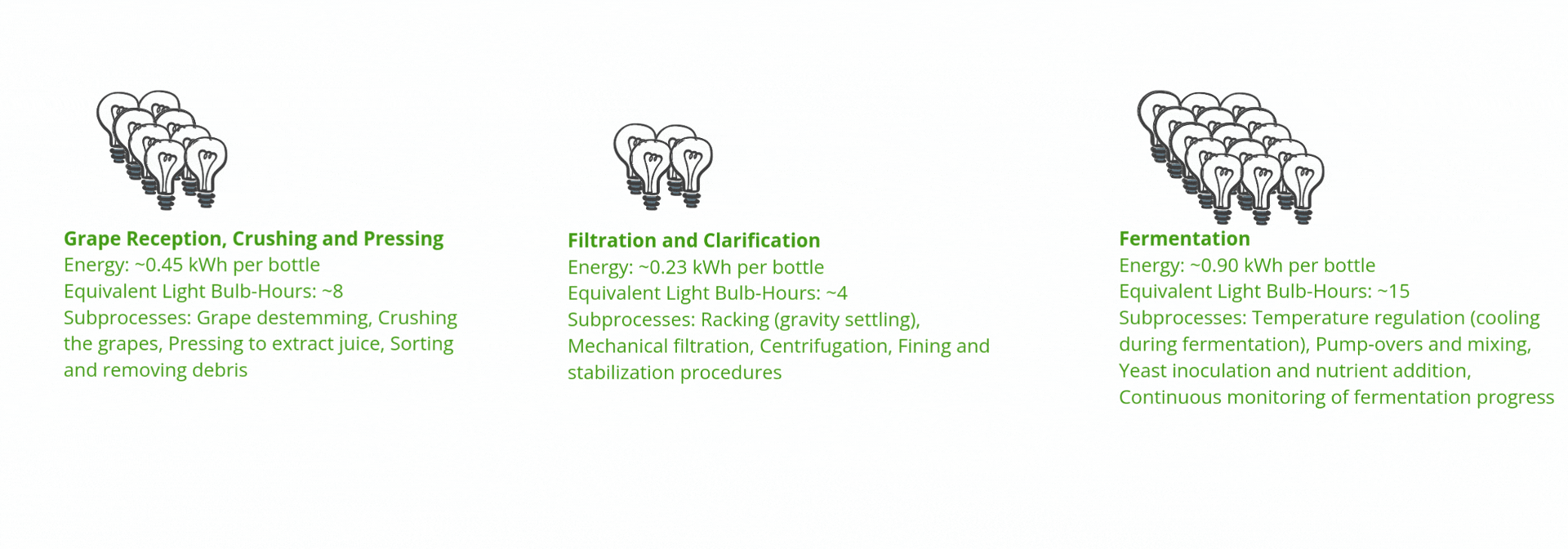
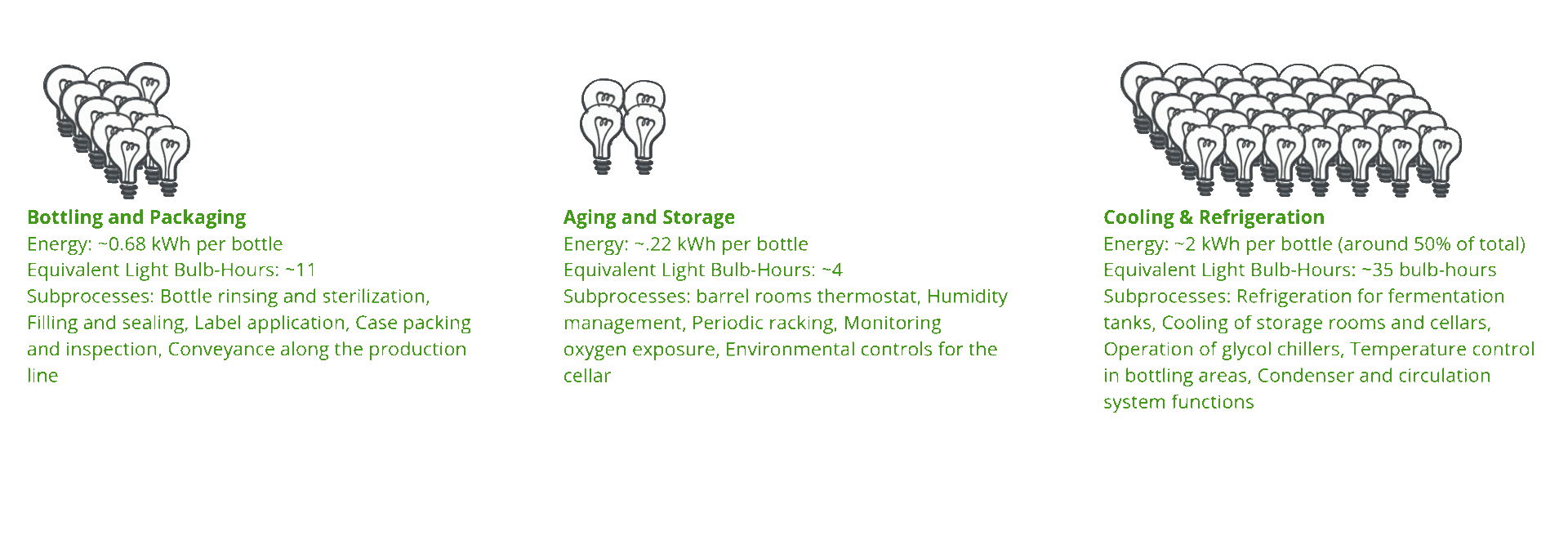
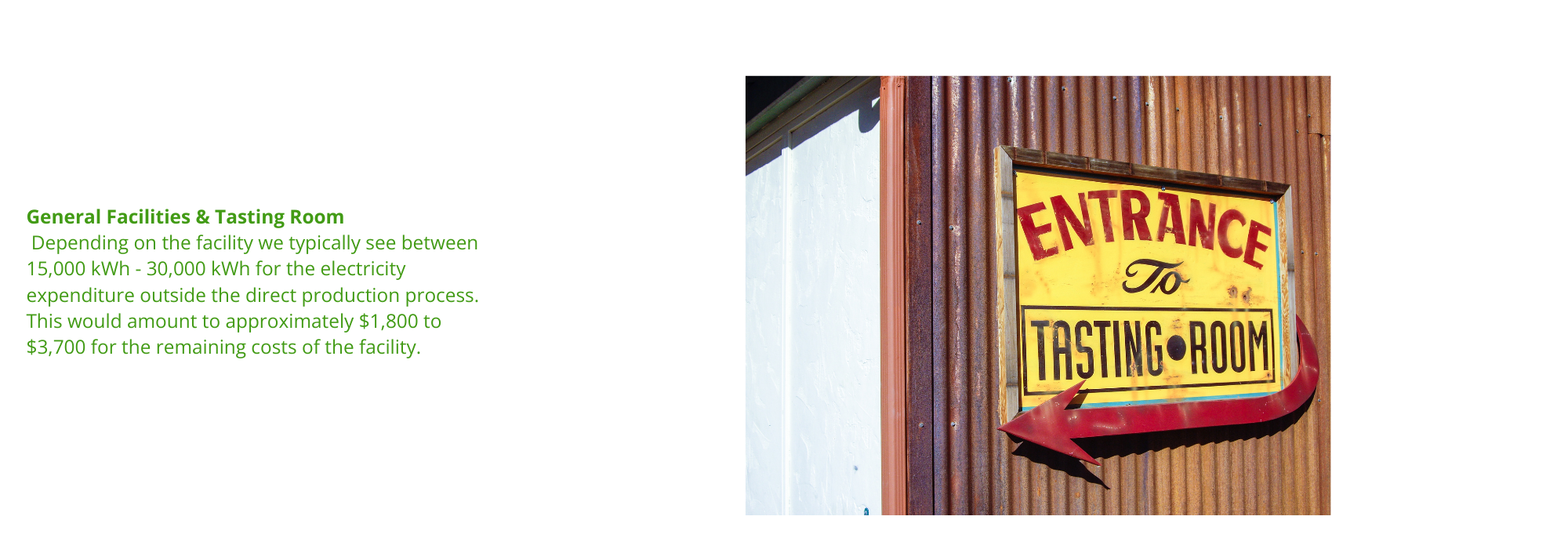
Annual Electricity Usage and Costs
Electricity Consumption and Costs for the Average Oregon Winery: A Solar Energy Perspective
As an Oregon winery owner, understanding your electricity consumption and costs is crucial for efficient operations and sustainability planning. The figures below reflect real-world data from an Oregon winery, factoring in both production facilities and tasting room needs.
Total Annual Consumption: Approximately 272,640 kWh1
Total Estimated Annual Cost: ~$33,4562
(Based on an average commercial rate of about $0.1226 per kWh in Oregon2)
Primary electrical energy uses include refrigeration systems for fermentation cooling, cold stabilization, and cold storage (45–90% of total energy use3), electric pumps for moving wine and must (18% of consumption3), electric-powered presses and crushers, bottling line equipment (18% of overall energy use3), compressed air systems (7%3), and the energy needs for lighting, HVAC, and point-of-sale systems in the tasting room.
How Many Solar Panels Does the Average Winery Have—and What Might It Cost?
For an average Oregon winery at 30 acres using about 272,640 kWh per year and producing around 60,000 bottles, a 200 kW capacity generally aligns with offsetting a significant portion of a typical winery’s yearly electricity usage. Because most commercial panels range between 400 W and 500 W each, a 200 kW system might require around 400–500 panels. The exact number depends on factors such as brand, model, and the amount of roof or ground space available. Oregon wineries can further capitalize on incentives like the Federal Tax Credit and USDA REAP grants to substantially reduce their net solar investment.
Investment Incentives
- Federal Investment Tax Credit: 30% off the installation cost6
- Energy Trust of Oregon incentives: Up to $15,000 available for businesses7
- USDA Rural Energy for America Program (REAP) grants: Can cover up to 50% of project costs8
Estimated Payback Period
Many Oregon wineries have seen payback periods ranging from 5 to 10 years, depending on system size and incentive utilization9.
Long-term Savings
Over a 25-year lifespan (the typical warranty period for solar panels), your winery could potentially save over $500,000 on electricity costs10—making solar a financially attractive and sustainable investment.
Additional Benefits
1. Hedge Against Rising Electricity Rates
Commercial electricity rates in Oregon have climbed by an average of 2–3% per year over the past decade (source: U.S. Energy Information Administration). By generating your own power, you shield your winery from these ongoing price increases and stabilize a core operational expense. This predictability can be vital for financial forecasting, particularly in an industry prone to fluctuations in grape yields and market prices.
2. Reduced Risk of Production Interruptions
During Oregon’s peak harvest season (typically August through October), wineries often see significant spikes in electricity usage. Fermentation tanks and cellars must be cooled to precise temperatures for yeast activity; pressing, pumping, and filtration equipment runs daily; and additional refrigeration may be required for must stabilization and storage. In fact, some wineries report that 40–60% of their annual energy consumption can occur in this concentrated harvest window (anecdotal reports from various Oregon wine producers). This is discussed in more detail in the next section of this page.
3. Enhanced Sustainability Credentials
Sustainability resonates strongly with today’s consumers, especially in markets like wine where brand narrative is influential. Research by the Wine Market Council indicates that over 70% of surveyed wine drinkers consider environmental practices a factor when choosing a brand. By showcasing solar-powered operations, wineries distinguish themselves in a crowded market, gaining positive media coverage and an eco-conscious reputation. This not only garners goodwill but can also drive higher direct-to-consumer sales and strengthen relationships with distributors seeking green-minded producers.
4. Potential Increase in Property Value
In a report by the Rocky Mountain Institute analyzing green building features—which included on-site renewables—properties often had 2–7% higher sale prices or improved net operating income when compared to non-green equivalents. Another analysis by the Appraisal Institute highlights how solar installations lower operating expenses, thus improving capitalization rates—a key factor in commercial real estate appraisals.
While these studies focus on commercial and mixed-use buildings rather than wineries specifically, the underlying principle remains relevant: onsite renewable energy assets signal stronger long-term cash flow, lower utility costs, and enhanced environmental responsibility. All of these attributes can resonate with potential buyers or investors in vineyard and winery properties, contributing to an overall premium in valuation—just as many residential homes with solar demonstrate in more widely published data (such as the 4.1% figure from Zillow’s analysis).
Real-World Examples from Oregon Wineries
- Large Winery in Oregon: Generates over 24,000 kWh monthly, with electricity costs exceeding $2,900 during peak periods4.
- King Estate Winery (Eugene): Installed a large-scale solar system generating around 1,000,000 kWh per year14.
- Belle Fiore Winery (Ashland): Achieved 100% solar power with over 500 panels generating approximately 250 kW15.
- Troon Vineyard (Grants Pass): Powers the entire farm with solar6.
- Stoller Family Estate (Dayton): Installed a 309 kW system, offsetting 40–50% of energy use7.
- Sokol Blosser Winery (Dayton): Uses solar to cover 30% of its annual energy needs8.
- Pfeiffer Winery (Junction City): Operates a 27.3 kW solar system, providing nearly 100% of the vineyard’s energy needs14.
- Kriselle Cellars (White City): Powered entirely by solar ground arrays, covering both production and tasting rooms15.
- Padigan (Medford): Supplies about 75% of its facility’s power through solar panels16.
- Left Coast Estate (Rickreall): Utilizes a 62 kW roof-mounted solar array that generates the majority of its electricity17.
Preventing Power Outage Disruptions During Oregon’s Critical Winemaking Period
Power shutoffs due to wildfires are a major threat to wineries, particularly because they often occur during the harvest and fermentation periods. In Oregon’s Willamette Valley, harvest typically takes place from mid-September to early November, with fermentation extending into late November12. This coincides with the peak wildfire season, when utilities may implement Public Safety Power Shutoffs (PSPS) to reduce fire risks13.
Empirical data from past wildfire events show that shutdowns have frequently disrupted winemaking operations. For example, in California’s 2019 wildfire season, power shutoffs affected wineries just as they were processing grapes, causing delays in crushing, pressing, and temperature-controlled fermentation14. Wineries such as Scott Harvey Wines in Amador County and SugarLoaf Crush in Sonoma County were forced to rely on costly generators or risk spoilage due to failing fermentation temperature control systems15.
The following calculations are based on the average Oregon winery, which spans approximately 30 acres. A standard Oregon winery consumes about 272,640 kWh per year, or roughly 750 kWh per day. However, during harvest and fermentation, daily electricity demand can increase significantly, reaching up to 1,200–1,500 kWh per day.
Optimized Solar and Battery Storage System for Critical Winery Loads
Since solar panels will supply power during daylight hours, battery storage is only needed for nighttime operation. However, instead of relying on an oversized battery system, wineries can implement load shifting, smart energy management, and thermal storage to optimize efficiency and reduce storage requirements. The estimated critical nighttime load—focusing only on fermentation temperature control, refrigeration, and essential lighting—is significantly lower than total winery consumption:
- Fermentation cooling & temperature regulation: ~400 kWh/night (with thermal storage integration)
- Refrigeration for wine storage: ~250 kWh/night
- Essential lighting & control systems: ~50 kWh/night
- Total nighttime critical load: ~700 kWh/night
For a three-day outage, a winery would need at least 2,100 kWh of battery storage. However, by incorporating thermal energy storage and load shifting, the battery size can be reduced to 1,200–1,500 kWh while still maintaining full operational resilience.
Solar System Sizing and Panel Count
To support critical winery loads during the day and recharge the battery system, the solar array must generate enough energy to power operations and store excess energy for nighttime use. The required system size is:
- Daytime critical load: ~1,000 kWh/day
- Battery recharge requirement: ~800 kWh/day
- Total solar generation needed: ~1,800 kWh/day
- Solar array required: ~400 kW
- Number of panels (assuming 450W per panel): ~900 panel
Reducing Battery Storage Needs Through Smart Energy Management
By implementing a combination of strategic energy management techniques, wineries can significantly reduce the size of their required battery storage while maintaining full operational resilience. These methods ensure that critical loads remain powered without the need for excessive battery capacity.
- Load shifting: Running refrigeration and cooling systems during the day while solar is producing, minimizing nighttime battery reliance and reducing nighttime energy storage needs.
- Thermal storage: Using excess solar power to chill water or glycol during the day, which can then be used for cooling at night without consuming electricity, effectively offsetting an additional ~200 kWh of nighttime demand.
- Overbuilding solar capacity: Installing a slightly larger solar array (500 kW instead of 400 kW) to generate surplus power during the day, reducing reliance on stored energy and ensuring a fully charged battery system by sunset.
- Backup generator integration: Using a small generator (100–150 kW) only when necessary, instead of depending on a massive battery bank, allowing the required battery size to be reduced to as little as 800–1,000 kWh when paired with backup generation.
Through these measures, the required battery size for an average Oregon winery can be reduced from the originally estimated 2,400 kWh down to 1,200 kWh for a solar + battery-only system, and as low as 800 kWh when combined with a backup generator. This results in significant cost savings while maintaining energy resilience.
Hybrid Backup Approach for Winery Resilience
For added security, some wineries integrate backup generators in addition to solar and battery storage. A 100-150 kW generator could provide supplemental power for prolonged outages, ensuring fermentation temperature control remains stable.
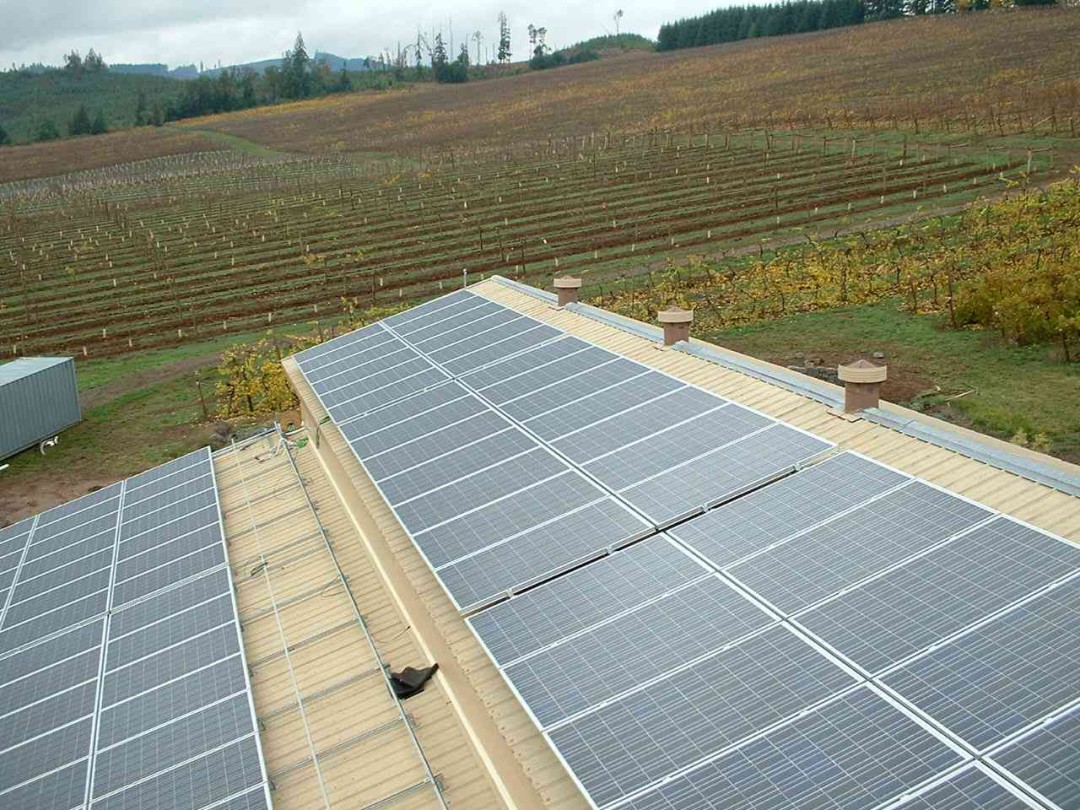
Pfeiffer Vineyards
Discover how Pfeiffer Vineyards, one of Oregon’s oldest and most renowned wineries, became a pioneer in sustainable winemaking. As the first Oregon winery to go solar, Pfeiffer’s 27.3 kW solar system, installed by Advanced Energy Systems in 2008, provides nearly 100% of the vineyard’s energy needs. This custom installation includes 122 Sharp modules, carefully positioned to maximize efficiency, with energy production monitored through DECK to track environmental impact.
Over time, Pfeiffer’s solar system will offset the equivalent of 800 tons of CO₂, 81,800 gallons of gasoline, or 2,400 trees.
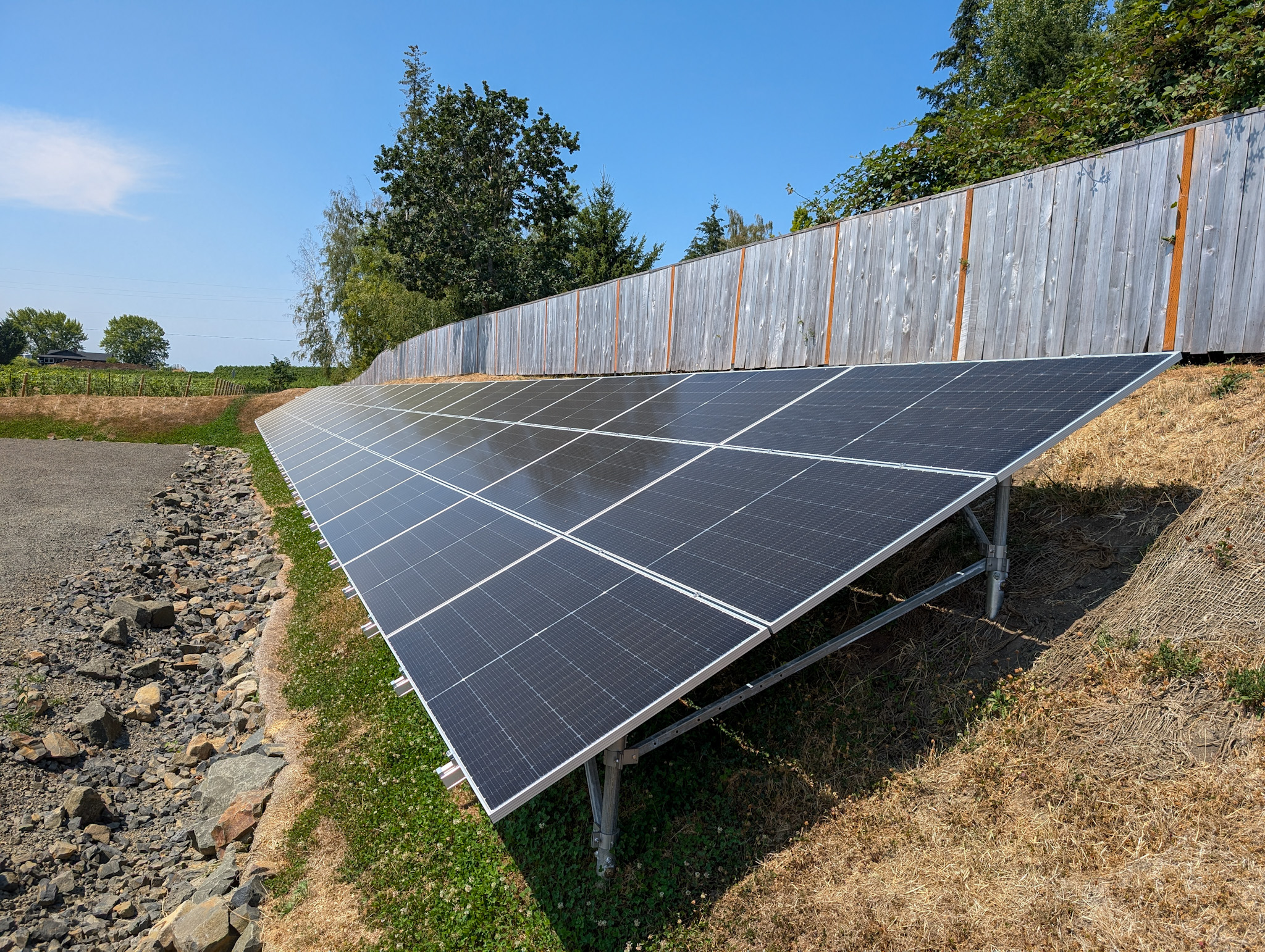
Balsall Creek Tasting Room
Balsall Creek Tasting Room: A Commitment to Sustainable Energy
Discover how Balsall Creek Tasting Room, a premier destination in Oregon’s wine country, is embracing renewable energy to support its operations. With a 43 kW ground-mounted solar system installed by Advanced Energy Systems, this project highlights a strong dedication to sustainability and energy independence.
The system features high-efficiency CSI CS6W-535MB-AG modules, strategically placed on a sloped berm to optimize sunlight capture. Paired with CPS 25 kW inverters, the installation ensures reliable, long-term energy production. Real-time solar monitoring allows for precise tracking of energy output and environmental impact.
Over its lifespan, this solar system will offset the equivalent of 643 tons of CO₂, 76,830 gallons of gasoline, or 17,510 trees, making a lasting impact on the environment.
Learn more about Balsall Creek Tasting Room’s commitment to clean energy and sustainability.

Be a trend starter and showcase your commitment to sustainability and innovation by embracing solar-powered winemaking. By incorporating a solar-themed label and image, you position your winery as a trendsetter in eco-conscious practices, appealing to modern consumers who value both quality and environmental responsibility. This branding not only strengthens your market position but also tells a story of forward-thinking values that resonates with today’s eco-aware audience. Stand out as a pioneer in the industry, attracting loyal customers who appreciate a wine that’s as sustainable as it is sophisticated.
High Efficiency Panels
Our solar panels are designed to maximize energy output, ensuring your business operates at peak efficiency.
Customizable Installations
Tailored solar installations that fit the unique needs of your winery or brewery, optimizing space and performance.
Real-Time Monitoring
Access live data and analytics to track your energy production and consumption, helping you make informed decisions.
Durable and Reliable
Built to withstand the elements, our solar systems offer long-lasting performance and peace of mind.

This underscores the benefits of agrivoltaics, a system where solar photovoltaic panels are integrated with agricultural operations. The dual-use of land for both solar energy production and agriculture helps vineyards cut down on energy costs and improve plant health by modulating the microclimate. Read more about the source of this quote.

Embrace solar energy to preserve the integrity of your terroir and reduce your environmental footprint. By harnessing the clean power of the sun, you maintain the natural balance of your vineyard, enhancing the unique characteristics that define your wines. Sustainable practices like solar power not only reflect a commitment to the environment but also contribute to the exceptional quality of your grapes. Let the sun empower your vineyard, ensuring your production never stops due to power outages.

Get Started with AES Today
Ready to harness the power of solar energy for your winery or brewery? Contact AES for a personalized consultation and discover how our solutions can benefit your business.
Works Cited
- 1 “2022 Oregon Vineyard and Winery Report.” Oregon Wine Board, industry.oregonwine.org/resources/reports-studies/oregon-vineyard-and-winery-report/. Accessed 29 Jan. 2025.
- 2 “Energy in Oregon’s Wine Industry.” Energy Trust of Oregon, www.energytrust.org/reports/winery-energy-use/. Accessed 29 Jan. 2025.
- 3 “Solar Energy for Wineries.” Solar Power World, www.solarpowerworldonline.com/winery-solar-energy/. Accessed 29 Jan. 2025.
- 4 “Energy Efficiency in Winemaking.” U.S. Department of Energy, www.energy.gov/energyefficiency-wineries. Accessed 29 Jan. 2025.
- 5 “Winery Power Consumption Study.” California Energy Commission, www.energy.ca.gov/winery-power-consumption/. Accessed 29 Jan. 2025.
- 6 “Grid Resilience for Agricultural Operations.” Pacific Gas & Electric, www.pge.com/grid-resilience-agriculture. Accessed 29 Jan. 2025.
- 7 “Battery Storage for Wineries.” Energy Storage News, www.energystorage.news/winery-battery-storage/. Accessed 29 Jan. 2025.
- 8 “Public Safety Power Shutoffs and Wineries.” Decanter Magazine, www.decanter.com/wine-news/psps-wineries-impacts. Accessed 29 Jan. 2025.
- 9 “Thermal Energy Storage in Winemaking.” American Society for Enology and Viticulture, www.asev.org/thermal-storage-wineries. Accessed 29 Jan. 2025.
- 10 “California Wineries and Power Outages.” Wine Business Monthly, www.winebusiness.com/news/winery-power-outages/. Accessed 29 Jan. 2025.
- 11 “Oregon Winery Solar Incentives.” Energy Trust of Oregon, www.energytrust.org/solar-incentives-wineries/. Accessed 29 Jan. 2025.
- 12 Willamette Valley Wineries Association. “Harvest Reports.” Willamette Wines, 2024, www.willamettewines.com.
- 13 Oregon Department of Forestry. “Wildfire Season and Power Shutoffs.” Oregon.gov, 2023, www.oregon.gov/forestry.
- 14 Decanter Magazine. “California Wineries Grapple with Power Outages.” Decanter, 2020, www.decanter.com.
- 15 Wine Industry Advisor. “Energy Security for Wineries Facing Public Safety Power Shutoff.” WineIndustryAdvisor.com, 2020, www.wineindustryadvisor.com.
- 16 Wine Industry Advisor. “Backup Power Costs for Wineries During PSPS Events.” WineIndustryAdvisor.com, 2020, www.wineindustryadvisor.com/2020/06/15/energy-security-for-wineries-facing-public-safety-power-shutoff/?utm_source=chatgpt.com.

